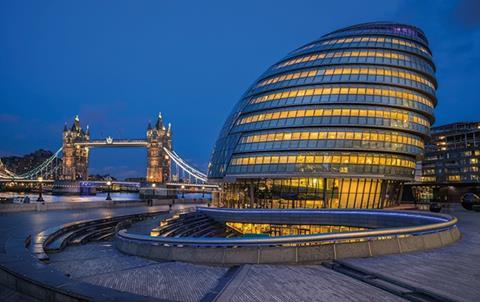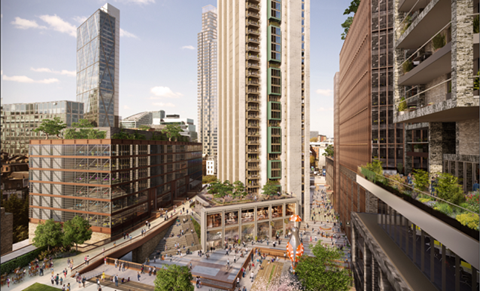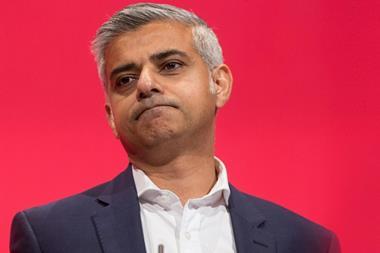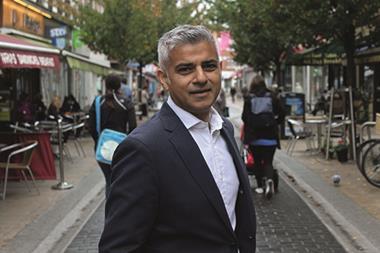Deputy mayor James Murray says housing developers have nothing to fear from the new regime in City Hall.

When James Murray took on the role of London’s deputy mayor for housing last month he had a reputation for being tough on developers.
He had formerly been head of housing at Islington council – a borough notorious for being a hard place to get developments through – where he maintained a hard line on affordable housing levels.
Last year, he brought forward controversial new rules to make it harder to avoid building affordable homes, and developers must now publish their viability assessments, unless keeping them confidential is in the public interest.
But now that he’s overseeing housing across the whole of London, Murray is willing to be – in his words – more “practical”.
He’s been on a charm offensive during his first few weeks in office: attending property events, giving speeches, having drinks with the industry’s top names, and generally crafting a pro-development image.
Murray keen to co-operate with property sector
Speaking to Property Week, Murray says he is keen to work “hand in hand” with developers as he bids to boost the level of affordable housing in London in a way that “encourages development”.
So what does this approach mean for the industry? Has Murray suddenly become developers’ best friend, or is he just using honeyed words?
Some see this “practical” approach as a sign that the mayor, and Murray, are reneging on their big housing promise. Before the election, Khan campaigned on a pledge that half of new homes would be “genuinely affordable” for ordinary Londoners. Now that aim, in Murray’s words, is just a “long-term target”.

Murray denies that the stance has softened – he says the current rhetoric matches what was promised before the election: “We were always very clear we wanted to move towards [a] 50% [affordable housing level], and we knew that wasn’t going to happen overnight.
“Setting it out post-election as a long-term strategic target is consistent with the commitment in the manifesto that we want to move toward.”
Murray insists that he is challenging developers still on affordable housing: new mayor Sadiq Khan’s mayoral campaign lambasted his predecessor Boris Johnson’s affordable housing record – and Murray hopes that the tough talk in the run-up to the election is enough to ensure developers build more affordable housing into their plans.
“When I’ve been going around speaking to people I’m clear we are ambitious, and we do want to see more affordable housing. If applications are coming in now, we’d expect them to work hard to increase the levels.”
“Now” is the operative word – Murray believes it is likely that developments that are already well under way will be left alone.
Plans for Bishopsgate Goodsyard
“When developments are very far down the line, to an extent you have to live with what you inherit for the first few months or years.”
This principle has implications for the two outstanding called-in schemes from Johnson’s era: Hammerson and Ballymore’s Bishopsgate Goodsyard, and the stadium-led development of the Wimbledon greyhound track, both of which boast less than 15% affordable housing.

On Bishopsgate, while Murray says that the two local councils involved – Hackney and Tower Hamlets – firmly objected to the low level of affordable housing, he admits that the stage the development has reached means the mayor may not be able to influence the detail of the scheme.
“In some of the call-ins we’ve begun to have discussions with officers, and we’ll be putting advice to the mayor in due course, and he will make the decision.
“There were obviously concerns raised by the local councils about the level of affordable housing in Bishopsgate. We’ve been clear we’ll look at every application on a case-by-case further down the line you obviously have less opportunity to affect them at that stage.”
Given the new mayor’s commitment to higher levels of affordable housing this could be seen as an indication that the Goodsyard scheme could be rejected.
One area in which Murray will be demanding a lot more from developers is public land, where the 50% target will become a hard and fast rule from day one. For example, the 50% requirement will be enforced on all TfL-owned sites, which the mayor sees as key to boosting housing numbers.
Tell us what you think
What do you think of Murray’s affordable housing stance? Comment below this story
Individual developments won’t all be expected to reach that figure, though – rather the target will apply across the programme of development.
“You might have a very high-value site in one area, and doing some shared ownership on that may not be meaningful,” explains Murray. “So it would be about getting the balance, but our expectation would be to get 50% across the programme.”
So, away from public land, if 50% is a long-term aim, what are the short-term goals?
That’s still unclear: Murray refuses to be drawn on what level of affordable housing he wants to attain during the mayor’s tenure in City Hall, whether 50% is possible, or even what level he would be happy with.
“It’s too early to tell the exact trajectory,” he says. “If we can pin down some certainty on how the planning system might work, work out the funding settlement [for affordable housing], and be clear about what we mean by affordable, then over the coming months it will become clearer where the initial milestones ought to be.”
Details yet to come

That is a lot of things still to work out. Much of the detail of the policy will come in the form of supplementary planning guidance, which Murray (pictured right) says will be made public “in the next few months”.
But he does hint at the direction of travel – he sees build-to-rent, for example, as central to solving London’s housing crisis, allowing homes to be built more quickly, and ensuring a greater mix of housing tenures.
To that end, Murray is preparing a new framework that will define what shape build-to-rent will take in London: how planning applications are treated, what affordable rent looks like, and what standards build-to-rent developments must meet.
The aim, Murray says, is to attract institutional investment into build-to-rent, particularly from overseas – if funds see a “stable, secure” framework that is “backed by City Hall”, they are more likely to plough their money in.
“We can give institutional investors the confidence that we support build-to-rent – that encourages investment. We’ll be talking to the big investors in the next few weeks.”
City Hall at odds with government on ‘starter homes’
It’s perhaps a welcome antidote to the government’s focus on home ownership. But it does put City Hall and Westminster at odds, especially over David Cameron’s landmark ‘starter homes’ policy.
The programme will provide first-time buyers with homes at a 20% discount of market value, giving a leg-up to those struggling to get on the property ladder. The government wants one in five new homes to be available at this discount.
Murray is sceptical of the plan, which he says just does not fit with London’s house prices. Even at a 20% discount, he says, most people will not be able to afford the homes, especially as the cap on starter home prices in London is set at £450,000.
He plans to push the government to rethink its plans for London, and put shared ownership front and centre.
“We believe shared ownership provides a better route to home ownership than starter homes in London,” says Murray.
“We’ll be having discussions with government about that. One big issue many Londoners on middle incomes face is [paying] a deposit. Shared ownership has the benefit that you [need] a lower deposit.”
Focus on viability
Another area of focus for Murray is viability. He insists change is needed as developers are “frustrated” by the current viability process, and that the industry would like “clarity” on the issue. Does that mean he will push for greater public transparency for viability assessments, as he did in Islington?
“There are slightly different variants on the model in terms of what’s transparent and at what stage and what’s published, so we’re talking to people and want to come to a settled view,” he says.
“There’s clearly a lot of arguments in favour of greater transparency, and we need to work out how to put that into practice.”
A rather non-committal answer, that, although one that hints of change to come. In fact, that sums up a lot of what Murray is saying at the moment. The new mayor had talked tough in the run-up to the election – but as yet, nothing is set in stone.
Similarly undogmatic, Murray is clearly keen to engage with the industry ahead of the publication of the crucial supplementary planning guidance, which will shape viability, affordable housing, and tenures in London.
If developers are serious about having the ear of City Hall, now is the time to make their voices heard.






























No comments yet